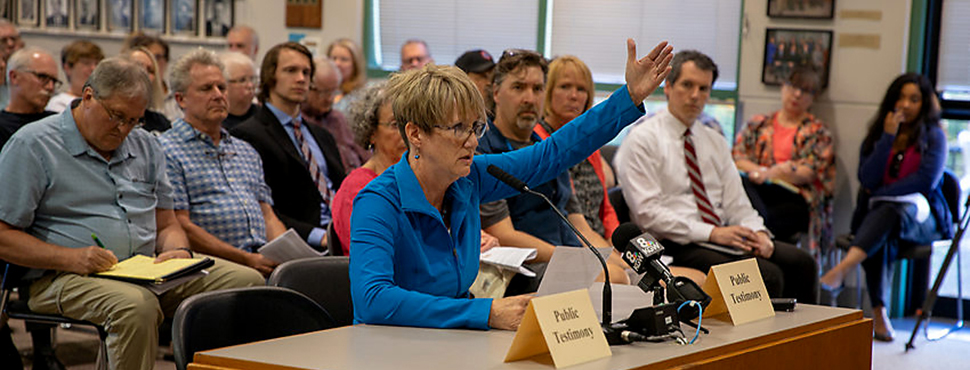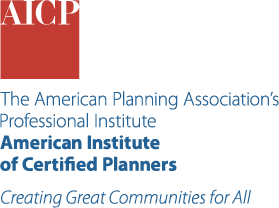Beyond Consensus: Redefining Successful Public Meetings

The fundamental component of public involvement in planning is the open public meeting. Managing an effective large process of any sort is challenging. But for planners, running a public meeting in today's polarized and short-attention-span times is more difficult than ever.
Compounding the challenge, planners are often not set up for success. University planning programs rarely offer training in public engagement. When I ask students how many real-world public meetings they have hosted, the answer is almost always none. Planning guidance often suggests the use of focus groups, advisory boards, charrettes, and other small-group processes, and workshops and trainings emphasize concepts such as "consensus" and "building trust." But how can planners build trust and reach consensus at a 90-minute public meeting with hundreds of participants, where factions have engaged in parking-lot conflict prior to the start?
There is no "trust" when it comes to large nuclear plant site visioning, nor is there any "consensus." In these situations, any process or planning project that specifies trust or consensus as a goal is doomed. The chimera of consensus fosters exclusion and frustration. Invocations of trust invite skepticism and ridicule.
What is a planner to do?
Focus On Process, Not Outcome
The answer is to separate the process of public engagement from the outcome. Planners must focus their efforts on creating a process that makes community members and professional stakeholders feel satisfied with their involvement.
As planners know all too well, it is impossible to end a public meeting by announcing a solution that everyone in the room (and in the larger community) agrees with. It is possible, however, to end a public meeting with all attendees agreeing that they were satisfied by the process — even if they do not particularly like any specific options that were presented.
Imagine hosting a large public meeting on a controversial community topic and being 95 percent confident that when you ask participants to score their satisfaction on a scale from 1 (awful) to 10 (wonderful), you will achieve a mean score of 8 or more. Imagine being able to repeat this for planning topics from land use planning to transit development, across states and in different countries, with the same confidence.
Twenty-five years of research demonstrate that this is indeed possible. Delivering high-performance public involvement, as measured by community members, professionals, and project sponsors, is a realistic, useful, and achievable goal.
This is how planners can arrive at "successful" public engagement in polarized times and for controversial topics: by planning and delivering meaningful public engagement processes.
QICE: A Framework For Success
How can planners achieve this new goal for public involvement?
Start by taking a structured approach. First, define performance indicators to address different stakeholder goals. Then measure public confidence. And then, select and sequence public involvement processes from a large toolkit using evidence-driven criteria, measure results, and iteratively demonstrate how citizen-sourced data is incorporated into the planning process.
Four criteria guide high-performance public involvement
- Quality: Measured by direct, anonymous, citizen-sourced Likert-scale process satisfaction scores; for instance, by electronic polling or written survey.
- Inclusion: Measured by the number of individuals or groups participating, or by using a representation index such as the proportion of disadvantaged participants.
- Clarity: Measured by the usefulness of publicly generated data for planners, engineers, and designers, determined via a qualitative scorecard or quantitative survey of these professionals.
- Efficiency: Measured as the ratio of quality, inclusion, and clarity to dollars spent. This may be qualitative (e.g., using categorical evaluation to compare public involvement effort to return) or quantitative (e.g., using combined numerical scoring for Q, I, and C as the numerator and dollar cost as the denominator).
By following this QICE framework, planners can relinquish unrealistic, self-defeating ideals about outcomes and focus instead on delivering high-performance public involvement processes.
Strategies for High-Performance Public Involvement
There are many actions planners can take to start moving towards high-performance public involvement.
- Quality is enhanced by being transparent, honest, and efficient with stakeholder time and investment demands. Start and finish meetings on time. No endless demands for more meetings! Maintain orderliness and transparency so that all participants can see how their fellow citizens evaluate planning options at each step. Do not force consensus; embrace differing responses to options or scenarios. Let people see how much their fellow citizens' responses differ. Promote discussion and probe differences using the group's own real-time response data, not with assumptions based on other communities' experiences.
- Inclusion may be improved by choosing accessible meeting times and locations. For instance, local churches, schools, and community facilities, and multiple public involvement methods, are used to bring the greatest number of community voices into the conversation.
- Clarity is improved by designing and evaluating scenarios that connect directly to planning criteria. For example, identify preferred design elements by asking the public to score a small set of visualized planning scenarios featuring factors like density or green space. Then, combine and iterate the most preferred elements in further visualized planning scenarios, demonstrating a clear relationship between citizen input and delivered outputs.
- Efficiency is increased by selecting and deploying public involvement methods that together deliver high levels of quality, inclusion, and clarity in proportion to total dollars spent on public involvement. For example, focus groups may deliver high quality but low inclusion and low clarity, while online surveying may result in high inclusion but low quality and low clarity. Keeping the bigger picture in mind can help planners choose the best engagement for the task at hand.
It's time to stop chasing the impossible dream of achieving perfect consensus in community engagement. Public meetings will always be messy. But quality, inclusion, clarity, and efficiency are goals that resonate with everyone involved in the public involvement process. When participants can walk out of a public meeting feeling satisfied with the process, that's a win that planners can aim for — and achieve.
Top image: Photo credit - Metro Council, Portland, Oregon


